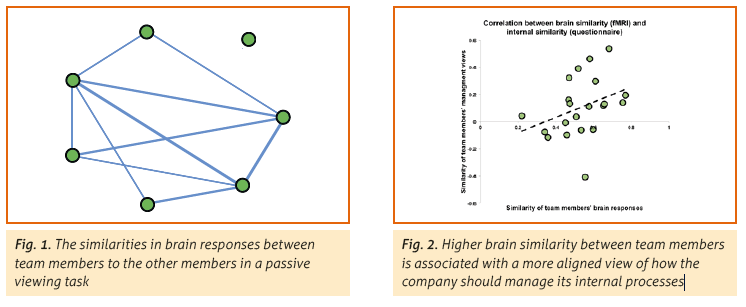Decision-Making in Management Teams
The present pilot study is a first endeavor in studying strategic decision-making in management teams using neuromarketing methods. This pilot shows that brain activity patterns obtained in a passive viewing task give insights in the nature of the interpersonal relationships between members of management teams. This suggests that a similar paradigm could be used to overcome the limitations of explicit measures when studying these by definition very intense relationships.
The success of a management team depends highly on the interpersonal relationships between the team members. On the one hand, management team members need a high level of interpersonal harmony as they collaborate very intensively with each other. In fact, many managers will have to admit they see other team members more than their spouses. On the other hand, successful managerial decision-making depends on interpersonal conflict. Tough decisions are made on a daily basis and a management team needs its members to be able to speak their minds and challenge each other, without feeling obliged to fall back on consensus just to preserve peace.
Thus, management team members have real relationships with each other: they share the good times and the bad times. As is true of any close relationship, it can be very hard for an outsider to understand the nature of relationships between team members. When a general manager talks to members, he or she can never be sure if he gets genuine answers or the answers that he desires. Similarly, when the manager decides to assemble sub-teams, for example when a new product is launched, how should that team be configured?
In this study, Neurensics collaborated with the universities of Nyenrode and Tilburg and the management team of the Dutch branch of the pharmaceutical company Novo Nordisk. This study aims to explore the fist difficult topic by answering two questions: Firstly, is it possible to assess interpersonal distance between members of a management team without having to rely on explicit answers? Secondly, are these interpersonal distances at the brain level meaningful at the managerial level? If the brains of two members are in sync, are these members also aligned in views on how the company should be run?
Approach
The study focuses on two questions:
• Is it possible to quantify the interpersonal distance of management team members by looking at the similarities of their brain responses when passively observing the other members of the team?
• To what extend are these interpersonal distances related to interpersonal distances between the members about strategic topics? Are brain-aligned members also more aligned in their views on how the company should be run?
Seven members of the management team were individually videotaped when answering three questions in a 1.5-minute window. The questions were:
- What is your vision on the company’s most recent new product introduction?
- Would you describe the challenges in your daily jobs?;
- What is your personal leadership style? The team members viewed the videos of the other members passively, while wholebrain activity was recorded using a 3T Phillips MRI scanner (32 channel DStream headcoil, TR=2000Ms).
This design allowed us to assess the emotions that are elicited by the other team members, without having to rely on explicit behavior. After scanning, the response to each video fragment was calculated using Neurensics 3D brain Mapper. For each pair of team members, we calculated the similarity of the emotional brain responses to the same colleagues. By calculating this similarity between all team members, we were able to create a Brain Similarity Network.
To investigate whether this network can reveal similarities between team members at a strategic level, we had them fill out a questionnaire after the scanning session. Crucially, this validated questionnaire is impersonal in nature. Instead, it measures opinions on corporate strategy. Specifi cally, the questionnaire assessed what internal and external factors were deemed important for the successful launch of a newly introduced product. Internal factors relate to internal corporate strategy, for example: how people should be hired, how to successfully work in teams, etc. Thus, how the company should be run. In contrast, external factors relate to the world outside of the company, for example: what new markets are important? What should be the marketing strategies?

The results of the brain similarity analysis revealed that ties exist between all team members. For illustration purposes, the figure shows the 50% strongest ties, leading to one member falling out of the network. Crucially, the interpersonal similarities at the brain level were signifi cantly positively correlated with the alignment in views regarding the management of internal corporate processes (ρ=.47; p<.05). There were no significant relationships with external processes found.
Conclusions
These preliminary findings suggest that when two members respond similarly to the team in a passive viewing task, their explicit viewpoints on very complicated internal corporate processes are more aligned. Naturally, these results should be regarded with caution. This being a first study, using only a single management team and focusing on a single product launch, means that there is a need to validate the findings in a larger research setting. Moreover, the results should be extended with an intervention design: using passively acquired team networks, could we configure small teams? And what would the effect of these interventions be on the effectiveness of these teams? However, the potential consequences from the results, if replicated and extended, could vary from hiring the right people for a job through composing effective teams given the importance or strategic relevance of an organization’s decisions.
Contact Information
Neurensics, Andries van der Leij